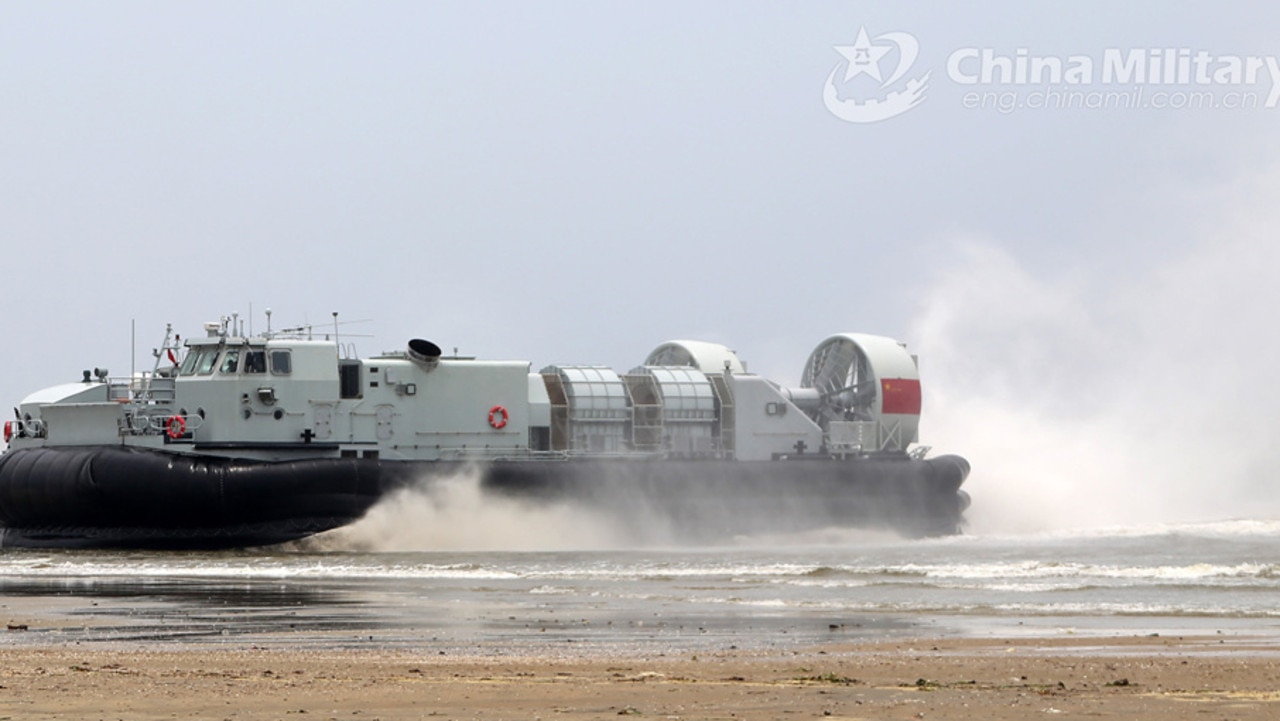Chinese military ‘could seize Taiwan’s government buildings’
China’s intensifying military drills and strategic preparations for a potential lightning strike on Taiwan have raised serious concerns for the island.

China’s making its ability to blockade Taiwan by sea and by air blatantly obvious. It’s also openly practising rushing troops and tanks on sandy beaches. But is it all a trick?
The idea of what an invasion looks like was firmly entrenched by operations in Europe, the Mediterranean and the Pacific during World War II.
Large numbers of troops and tanks are massed together and loaded on ships. These follow an overwhelming assault force of aircraft carriers, warships and strike aircraft before disgorging their cargoes on remote shores.
But some strategic analysts warn that any invasion of Taiwan may be over long before its allies can respond to help.
Taiwan’s rugged coastal terrain does not make such a scenario practical, says US think-tank chief and geopolitics author Dmitri Alperovitch.
Instead, he argues, China’s opening moves would more likely mirror those of Russia during the first days of its invasion of Ukraine.
A large force of Spetsnaz and paratroops in low-flying helicopters dashed across the border as the first shots were fired to seize Kyiv’s major airport. Their goal was to secure it for a follow-up surge of troops to rush the capital city’s seat of government.
Only prior warning from the US gave Ukrainian troops enough time to render Antonov Airport unusable and mount a spirited counter-attack.
Evidence Beijing has long been planning a similar “lightning” strike at Taiwan’s government and command network may be hidden in plain sight.

A mockup of Taiwan’s presidential palace has been built in a remote desert military training ground. There’s also a replica of the streetscape around Taipei’s parliament house and executive government centres.
These would likely be the target of pre-positioned agents and a fast helicopter assault.
At the same time, precision strikes and special forces would be aimed at securing the island nation’s key ports. A reinforcement unit of marines would then likely rush up the river through the heart of Taipei to help secure the government district.
“All of this can happen literally within the first 30 minutes of action,” Alperovitch warns.

The heat is on
“Lai Ching-te is the first leader of the Taiwan region to be surrounded by the PLA upon taking office as a warning,” says state-controlled Global Times propagandist Hu Xijin. “Figuratively speaking, this military exercise is akin to the newly appointed Lai authorities making arrogant statements, then the mainland’s military directly seizing him and putting him in a birdcage.”
China has engaged in intensive military drills all around the island nation since the inauguration of its new democratically elected President, (William) Lai Ching-te, on May 20.
The exercise, dubbed Joint Sword 2024A, involved significant elements of the People’s Liberation Army, Navy, Air Force and Rocket Force.
“This is also a powerful punishment for the ‘Taiwan independence’ separatist forces seeking independence and a serious warning to external forces for interference and provocation,” China’s Eastern Theatre Command spokesman Colonel Li Xi told local media.
It was a message reinforced by a Beijing department created explicitly to tackle Taiwan.

“As long as the “Taiwan independence” provocations continue, the People’s Liberation Army’s actions to defend national sovereignty and territorial integrity will not cease,” State Council Taiwan Affairs Office spokeswoman Zhu Fenglian said on Wednesday.
However, similar exercises on the edges of Taiwan’s territories have been conducted on an ever-increasing basis for the past several years.
“It’s clear that the operational tempo of these exercises has changed, and it’s accelerated to the point where a lot of these exercises are now happening on the eastern side of the island,” Republican Congressman Andy Barr, co-chair of the Taiwan Caucus, told US media on Thursday.
“It’s clearly a trial run or practice for an encirclement or a blockade of the island.”
The carefully choreographed exercises, however, are repetitive.
Some suggest they may be designed to create a false impression of Beijing’s plans.

The best laid plans …
Most Western “war game” scenarios assume a Chinese air and sea blockade and massive mobilisation ahead of a D-Day style landing would give the US, Japan and other Taiwanese allies time to respond.
But Alperovitch warns that removing Taiwan’s executive government in the opening hours of a war would give the US pause. There would be no leader – like Ukraine’s Volodymyr Zelenskyy – to rally Taiwan’s troops and entrench a spirit of resistance in its population.
And such a surprise attack would need only China’s specialist fleet of assault ships, he explains.
“Each of them can deliver about 800 troops and more importantly, dozens of troop transport helicopters as well as gunships to do an airborne assault. They can reach the two (main) airports within 10 to 15 minutes,” Alperovitch explains.

Only then will Beijing need to activate its vast fleet of civilian ferries – designed and built to military specifications to carry main battle tanks. These can deliver the main occupation force via Taiwan’s commercial roll-on and roll-off port infrastructure.

“You’re going to have these transport ships, mostly civilian vessels and have been loaded with the hundreds of thousands of troops, armoured vehicles, tanks and logistics that you need to occupy an island of 23 million people,” he told US media this week.
And if Taiwan’s ability to mount an organised resistance collapses within the opening hours – or days – of an attack, its allies will be left pondering the price of retaking the island from China.
“You’re going to lose ships. You’re gonna lose a lot of sailors – thousands, potentially tens of thousands of American troops out there,” Alperovitch warns.
Jamie Seidel is a freelance writer | @JamieSeidel






